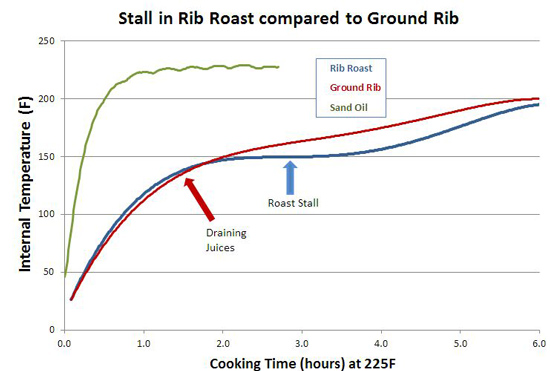The brisket stall temp – a term that strikes fear into the hearts of even seasoned barbecue enthusiasts. This frustrating phenomenon can leave your perfectly smoked brisket seemingly stuck in neutral, its internal temperature refusing to budge. But fear not, grill masters! This introduction dives into the world of the Brisket Stall Temp, explaining what it is, why it happens, and how to navigate this often-dreaded plateau.

What is the Brisket Stall?
The brisket stall is a frustrating yet natural part of the smoking process. It occurs when the internal temperature of the brisket plateaus, typically around 160-165°F (71-77°C), and seems to stop rising for several hours. This can be deceiving for BBQ enthusiasts, but it’s actually a crucial stage.
The Science Behind the Stall
Two main factors contribute to the stall: evaporative cooling and connective tissue breakdown. As the brisket cooks, moisture evaporates from the surface, creating a cooling effect that counteracts the smoker’s heat. Additionally, collagen in the meat breaks down into gelatin during this time, which requires energy and can slow down the temperature increase.
Overcoming the Stall: Techniques and Patience
There’s no magic bullet to bypass the stall completely, but you can employ a few methods to navigate it effectively. Here are some popular options:
- Increase Cooking Temperature (Slightly): Bumping up the heat to 290-350°F (143-177°C) can shorten the stall by accelerating the evaporation process. However, be mindful not to overdo it, as this can affect the texture and moisture of the brisket.
- The Texas Crutch: Wrapping the brisket in foil or butcher paper helps retain moisture and heat, pushing through the stall more quickly. This technique is a favorite among many pitmasters.
- Water Pan: Adding a water pan to your smoker increases humidity, which can minimize the cooling effect and potentially shorten the stall.
Important Tips for Managing the Stall
- Patience is Key: Don’t fight the stall by cranking up the heat excessively. The breakdown of connective tissues is essential for tenderness, so let the process happen naturally.
- Monitor Internal Temperature: Use a reliable meat thermometer to track the brisket’s internal temperature. This will help you gauge the progress and determine when the stall is over.
- Plan for the Stall: Factor installs time when estimating your overall cook time. This will prevent unnecessary stress and ensure you don’t rush the process.
Brisket Stall Myths Debunked

There are a few misconceptions surrounding the brisket stall. Here’s setting the record straight:
- Myth: Wrapping the brisket eliminates the stall.
- Fact: Wrapping can shorten the stall but doesn’t bypass it entirely.
- Myth: Higher temperatures prevent the stall.
- Fact: The stall is a natural part of the process, and excessively high heat can compromise the final product.
The Importance of Resting After the Stall
Once the brisket overcomes the stall and reaches its final temperature (usually around 200°F or 93°C), resist the urge to slice it right away. Allow it to rest for at least 30 minutes to an hour. This resting period allows the juices to redistribute throughout the meat, resulting in a more flavorful and tender brisket.
Final Thoughts: Embrace the Stall and Enjoy the Journey
Understanding the brisket stall empowers you to manage this stage effectively and achieve consistent, mouthwatering results. Embrace the learning curve, experiment with techniques, and be patient throughout the process. Remember, successful brisket smoking takes time and practice, but the rewards are truly delicious.
Key Takeaways:
- The brisket stall is a natural pause in temperature rise during low and slow smoking.
- Evaporative cooling and connective tissue breakdown cause the stall.
- Wrapping, slightly increasing heat, and using a water pan can help manage the stall.
- Patience and proper monitoring are crucial for a successful cook.
- Resting the brisket after the stall allows for optimal tenderness and flavor.
With this knowledge and dedication, you’ll be well on your way to becoming a brisket-smoking champion!
References:
FAQ About Brisket Stall Temp: Understanding The BBQ Stall
Q: What is the BBQ stall or brisket stall?
A: The BBQ stall, also known as the brisket stall, is a phase during low and slow smoking when the internal temperature of the meat plateaus. This can last for several hours, causing frustration to many pitmasters.
Q: Why does the brisket stall occur?
A: The brisket stall occurs due to evaporative cooling. As the meat’s moisture evaporates during cooking, it cools the surface of the meat, creating a barrier that slows down the temperature increase.
Q: How long does the brisket stall last?
A: The brisket stall can last for a few hours, depending on various factors, such as the size of the brisket, the cooking temperature, and the humidity in the smoker. It is common for the stall to occur when the brisket’s internal temperature reaches around 150-170°F (65-77°C).
Q: How do you overcome the brisket stall?
A: Once the brisket enters the stall phase, you can wrap it in foil or butcher paper to overcome the stall. This method, known as the Texas crutch, helps to power through the stall by retaining heat and moisture around the meat.
Q: Should I be concerned about the brisket stall?
A: No, the brisket stall is a natural part of the smoking process and is nothing to be concerned about. It is essential to be patient and allow the meat to continue cooking until it reaches the desired tenderness.
Q: Can I speed up the brisket stall?
A: To speed up the brisket stall, which goes against the low and slow cooking methods, some pitmasters choose to increase the cooking temperature slightly to push through the stall faster. However, this may affect the final texture and moisture of the brisket.
Q: How do you ensure a successful brisket cook despite the stall?
A: To ensure a successful brisket cook despite the stall, it is crucial to maintain a consistent cooking temperature, monitor the internal temperature of the meat using a reliable meat thermometer, and plan by allowing enough time for the stall phase.

The Stone’s Sports Grill and Bar was Established on December 1, 2021. The Stone is a Sequel to another restaurant called Cornerstone’s First Edition in Tucumcari, NM. This particular venue is located on the Southeast side of Colorado Springs. The Stone is Wide Open. We have a large dance floor, multi-level stage, pool room, (5) dart boards, and a bar with a large selection of wine spirits and brews.